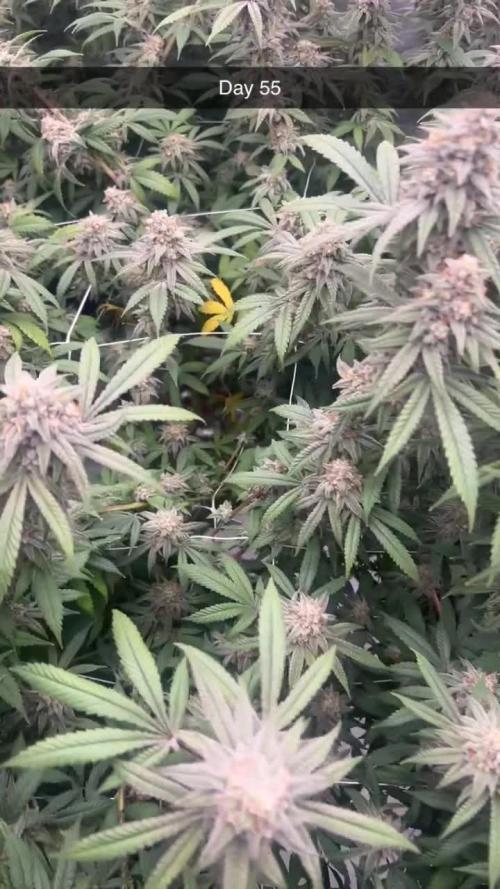The Grow Awards 2026 🏆 





























Likes
11
Share


@Smokeallot
Follow
Ok here we grow , starting the first week of flower on these 6 clones of Canuk seed strains. Looking really healthy , let’s see what the best 8 weeks brings. Happy growing everyone 🌱✌️
Likes
4
Share


@SEGA_Y_Griega
Follow
13.3.23 verschüttetes sauberes Wasser 150 (ppm) hervorragende Entwicklung im Moment
Do-Si-Dos-OG-Cannabis-Samen sind ein weiteres von der US-Westküste inspiriertes Meisterwerk. Es war nur eine Frage der Zeit, bis Girl Scout Cookies mit unserer Colorado Ghost OG kombiniert wurde, die beide das Rückgrat unseres Strain-Sortiments bilden, um diesen potenten, indicadominanten Hybriden zu kreieren, der nach nur 60 bis 65 Tagen Blütezeit erntereif ist. Gönn deinem Körper und Geist eine entspannende, stimmungsaufhellende Behandlung mit diesem Raucherlebnis par excellence, das mit dem Geschmack von süßem Gebäck und vollmundigen, sahnigen Aromen deinem Gaumen schmeichelt.
Alle schriftlichen und visuellen Materialien sind nur für Informations- und Bildungszwecke bestimmt.
Diese Woche habe ich mich entschieden, ein großes Zelt Mars Hydro 120•120 zu installieren, für eins und eine Lampe mit großer Reichweite FC E4800. Ich habe die Klimaanlage eingerichtet, jetzt liegt die Temperatur bei etwa 24, ich habe zwei Lüfter installiert, um den Secret Jardin Monkey Fan 20w zu blasen, ich wollte sie schon lange kaufen. Die Heizung funktioniert auch! Hoffe es wird bald wärmer 😅
Likes
24
Share


@SMELLYBUDZ
Follow
Week 3 day 7.
Buds are getting icey and stretching around 1-2” a day.
Dropped the carboload and is going to be replaced by a PK booster (big bud).
Watering everyday. Plain RO on every 3rd water.
The kind LED is pissing on the hps if im being honest. Bud development and vigor seems a lot nicer.
Stay baked.
Likes
8
Share


@mikearon
Follow
April 26th - Day 69 : Oh my god look at them.. So bushy after that defoliation. They're doing great I think.. The only concern was the laggyness of the leaves but I guess it's due to overwatering so I'll chill with water for a day or two. I started trimming the lower branches that I think aren't getting enough light. I'm trying to push the veg stage as much as I can let's see if they can take an extra few weeks.
Likes
179
Share


@Tropicannibis_Todd
Follow
💩Holy Crap We Are Back At It And Loving It💩
Growmies we are at DAY 28 and she's just killing💀it👌
👉We are in the Preflower stretch 👈
So Shit , I gave them just a tad to much nutes on the last feeding 👈 But I have since fixed it
So I'm starting to pull her over and do some low stress training 🙃 and some defolation 😳
Lights being readjusted and chart updated .........👍rain water to be used entire growth👈
👉I used NutriNPK for nutrients for my grows and welcome anyone to give them a try .👈
👉 www.nutrinpk.com 👈
NutriNPK Cal MAG 14-0-14
NutriNPK Grow 28-14-14
NutriNPK Bloom 8-20-30
NutriNPK Bloom Booster 0-52-34
I GOT MULTIPLE DIARIES ON THE GO 😱 please check them out 😎
👉THANKS FOR TAKING THE TIME TO GO OVER MY DIARIES 👈
Likes
10
Share


@Papastroumf
Follow
Day 66 : Her buds are full of crystals and are so dense. The smell is really strong stinky skunk like GZ , but GZ smell is more acidic. Her crystals are milky and soon will start to amber. Breeder refers that will be pretty mature in 70 days. Not in my case :D we will see in 4 days, in next watering. For now no ambers. I prefer to cut when we have 15%-20% amber and 80%-85% milky, because after the smoke is very heavy for my taste.
Edit Day 70 : She watered with juices and i continue until i see first signs of amber trichomes. Still no ambers. She has gained so much weight , side branches cant lift their self. I think she will be the heavier. You can understand her weight if u lift it.
Likes
19
Share


@Wenz004
Follow
Fast schon ende der 4. Woche aber jetzt erstmal Woche 3 eintragen.
EC ca. auf 1.1
Am Anfang der Woche 3 in 19 l fabric pot umgetopft.
Ab Dienstag 4 Tage unterwegs daher die Schläuche für Blumat...hat ganz gut funktioniert mit Umwälzpumpe im Tank plus dass "Jemand" täglich PH korrigiert hat.
Video ist ca. 19.10. bis 26.10. plus bissl vom 27.10
Schon mal vorab... Samstag bis Mittwoch (Woche 4) auch unterwegs...nur das es "Jemand" nicht gab und Blumat auch noch verstopfte...Pflanze hat gelitten aber Spoiler muss sein...die Frau mit dem fetten A.... wurde geretet.
Aptus schein für Blumat ungeeignet zu sein...mit TA gabs weniger Probleme bei einem älteren grow...Aptus bleibt aber zunächst mein Favorit.
Likes
32
Share


@Weediz
Follow
Day 71: The left plant is starting to show some of the same problems I see on the right plant so I am going to flush her too tomorrow. I think that it is mostly due to the light stress from before, it is just showing now, but to be safe she gets a flush too @5.8 ph
Day 73: Hmmmm... It is difficult to see if the problem persists, or its just the affected leaves that will not recover. Should I remove these "sick" leaves? - They seem to be happy abut the new light intensity as some of the problems is defiantly improving like the leaves are praying, and the sides of the leaves does not seem to bend as much. I have been very gentle with the feeding, after having done 3 flushes (15L at 5.8 ph) and have updated my feed schema above
Day 75: I am sure that I had some light-stress, and it is over now, but I don't think I see a full recovery.... I think I see the leaves to get more yellow but it might just be as mentioned before, that the sick leaves won't recover but I do not know what to do from here. Should I just leave them, or do you growmies have any suggestions? The grow has, and is, very slow in my opinion but I still see progress
UPDATE: I decided to doe some heavily defoliation. It might have been too much for the left one. I haven't done much defoliation, but they where so bushy, that I thought it was necessary to get light on all my buds. Also I wanted to get rid of those "sick" leaves. I think I am on the right track, and the symptoms I see are old problems now
Likes
4
Share


@Dankgrowz786
Follow
Fire 🔥 she smoked nice. Smooth and got a sexy taste. Overall a easy grown and will try again
Likes
76
Share


@Canna96
Follow
This week went pretty well. I ended up attaching a line to each corner of the plant, and tying it off to the pole in corner. This really opened up the plan, and exposed a bunch of lime green that wasn't getting quite enough light. Other than that, I switched to ripening nutrients for these last two weeks or so, and I plan to flush her for five days or so. I am thinking about 2 and a half to 3 weeks until she is ready to come down. Temperatures are getting high again in my region, but I am able to hold about 78 degrees F in the tent, and about 42% RH. Not much to do until harvest time, just wait and hope that piglet continues to fatten up. I hope everyone had a great weekend, stay safe and Blaze On!
Likes
10
Share


@majic_happen
Follow
day 44
- The growth process continues unabated. I am waiting for the desired size. 8 days after flowering it didn't grow as much as I thought it would, so we went back to the growing season. 👽
day 49
- I decided not to cut the leaves anymore after much defoliation. It easily tolerates strong stress easy to grow.
Likes
77
Share


@TOTEM
Follow
This is a very interesting week!
After mainlining, I transplanted the lady into a 3L AirPot, adding 3 spoons of Mykos by Xtreme Gardening, 45g of BioMagno Algae and 5g of BioMagno Neem Flour. I uploaded a time-lapse video that shows the process.
Then I fed her with the nutes you see above this comment, in 1L of water (actually, 750ml would be better).
I hope you liked this week content!
Day 28 (May 7, 2019): 0.5L of tap water with Activator @ 0.5ml/L and Rizostimo @ 1ml/L.
Likes
6
Share


@Bwright_315
Follow
She is growing like a champ. The only issue I have with her so far is watering she feed like crazy. Excited to see what the future hold for her.
Likes
31
Share


@TheHighentist
Follow
30/7
-Temp 23-27day/21-24night
-45%RH (2+-)
31/7
-Temp 23-26day/21-24night
-44%RH (2+-)
1/8* Water day / flush
-Temp 23-27day/22-24night
-43.5%RH (2+-)
2/8 Slowly getting ready for harvest.
-Temp 23-26day/21-24night
-43.5%RH (2+-)
3/8
-Temp 23-26day/21-24night
-43.5%RH (2+-)
4/8 Day before harvest, shut the lights off till tomorrow.
Trichomes, smell and looks are just like i want it. Very satisfied.
5/8 Harvest day - Converting grow tent to dry tent.
Likes
9
Share


@Luv2Grow
Follow
Day 57 - Starting off week 9 and she’s looking gorgeous still. Decided that I’m going to give her straight pH’d water from here on out. Trichs are mostly milky and caught a couple amber today. Thinking another week or two and she should be ready to chop but will keep a close eye on everything. Has been such an easy grow so far, just didn’t end up as big as I expected but buds are really fat and frosty.
Day 58 - Nothing new to really report. Going to continue giving her straight water and cal-mag. Didn’t notice much change from yesterday, thinking she might of stalled out a bit but hopefully these last two weeks she’ll really start packing on.
Day 59 - Not noticing too much of a change the last couple of days, no new pistils showing and she’s starting to shrivel. There’s a few amber trichs in there but pretty much completely cloudy. Debating on a partial chop this weekend. Still flushing and giving her just water. Hopefully I can hold out chopping until the end of week 10 at least.
Day 60 - She’s still looking good and REALLY frosty. Half the pictures I take almost look fake, she’s so frosty. Continuing just water to flush her out till the end. Decided I’m not gonna do a partial chop and just let her go till I think she’s done and hopefully more amber trichs.
Day 61 - She’s still holding strong and still seems to be fattening a bit. Going by the trichomes, she should be ready for a harvest by the end of week 10, next weekend. Just going to continue watching her and if she needs more time, I’ll give her more time!
Day 62 - No big changes, still looks like she’s on track for chopping next weekend. Will check her out again tomorrow and give her some more water. Can’t wait to start drying this girl, she’s smelling amazing.
Day 63 - Last day of week 9 and she’s smelling really good. Still flushing her and think I might chop next Saturday. Will be 10 weeks total but we’ll see, continue watching the trichs.

























